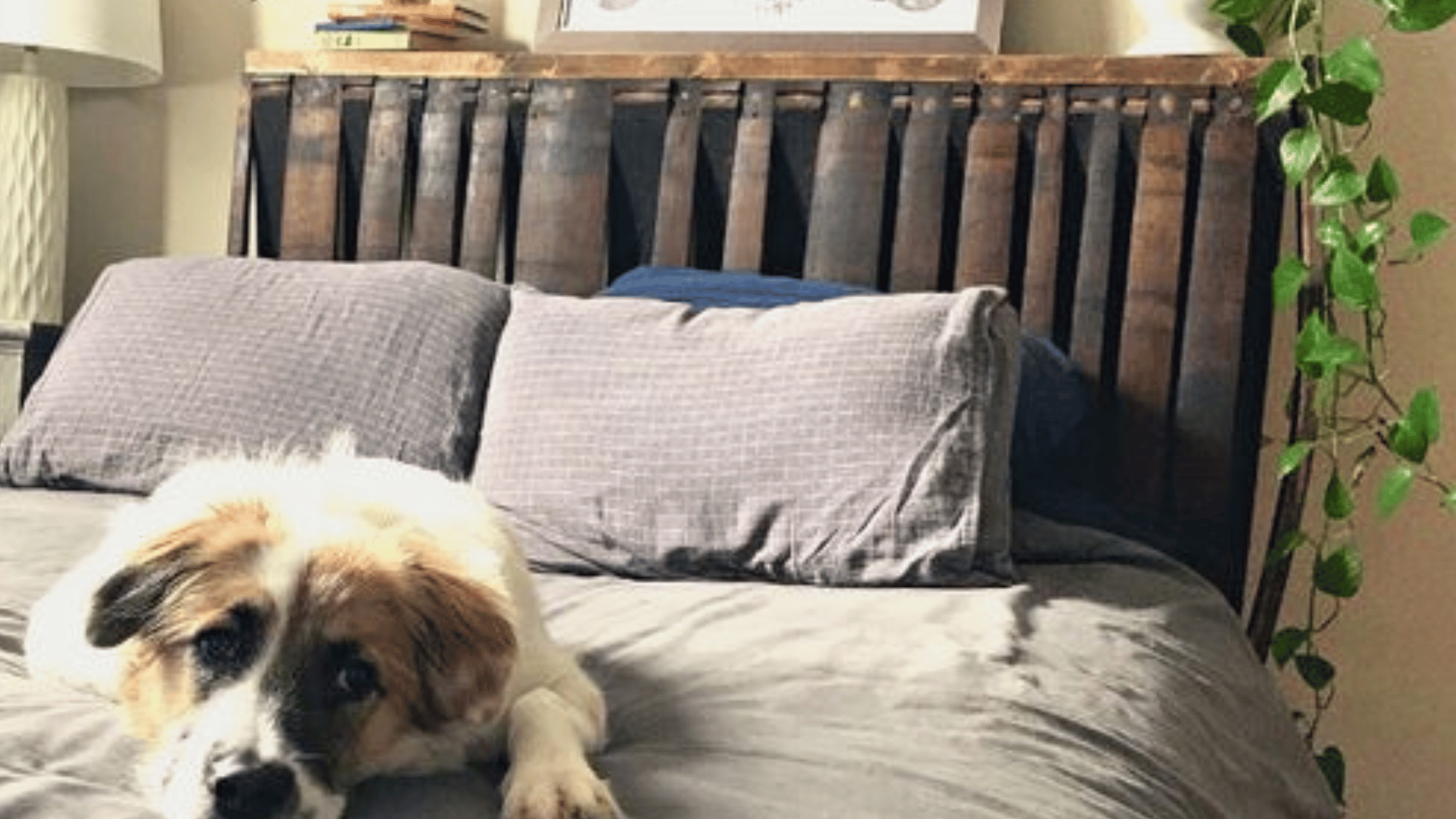I cound an old Whiskey Barrel and through it would make an beautiful headboard. I wants wrong! Here is how I did it!
I did this before building out the framework which made the final design much more complex than it needed to be. “The Whiskey Barrel Project” quickly became the “I Wish I Didn’t Project” before I could even get down a Whiskey Neat.
The Mistake
However, I do not believe in mistakes, I only believe in learning lessons. Choosing to apply that lesson or not is where I often find my problems. But I wasn’t making whiskey out of corn here. This DIY isn’t rocky science. Some things just take a little longer to DIY than anticipated.
Palmer’s Properly Lessons:
(get it?)
DIY 101: The Framework
“To build upon anything, the foundation must be built first.”
If I had built the foundation first, I would have made a frame by first using two, 5 foot 2 x 4s for the top and middle section of the headboard. I would have then used two, 4 foot 2 x 4s as the side ends that hold the framework together. It makes perfect sense to do this first because you would then have something to build out the whisky barrel section.
As I typically do, I missed the most simplified solution and did the reverse.
The Solution
I knew a solution to my mistake wasn’t too far from my mind. Working backward a bit, knowing that I did, royalty f*CK it up, I managed to redesign a framework that fits onto the backend of the visual component (the Whiskey Barrel section) of the headboard previously built.
I did this by using the backside of the piece’s, top and bottom sections as the existing framework. I then added 3 additional 2x4s measuring 4 feet each. One in the middle, and 1 on each end.
Using 2 ½ inch screws, the 2x4s were drilled into place using 2 screws at each intersection where the newly built framework and previously built top and bottom sections meet.
So far that’s two trips to Home Depot, 5 pieces of 2×4, and a lot more headache than anticipated. I soon found it wouldn’t be my last tally of trips to the hardware store, not a headache.
Another Road Block
Letting the piece rest for the night I woke to find I still wasn’t back on course with the anticipated concept design. (Let’s be real though, there wasn’t one). I’m not sure if it’s the shape of the barrel or misguided alignment of my end but the structure seemed wonky after its rest overnight. Who am I kidding? I work in data, it couldn’t have been my numbers. The screws used to attach the 3, 2x4s seemed to have pulled away from the section mounting the barrel; the first component of this project. So it problem must exist within the design of the screws. Obviously.
Knowing this mishap wasn’t me, of course, I pulled together an idea to counteract the wonkiness. This final piece of 2×4 was added as a brace to the back section in hopes of better stabilizing the structure, I think.
So far this still seems to be working. If things change you’ll be the first to know.
Despite the few misguided detours along the way, the piece still looked incredible from the backside. The anticipation of seeing the final design was tugging at my curiosity so I gave in and flipped the day’s work over to gaze upon my creation.
It’s Looking Great!
From the front-facing side, I was overwhelmingly pleased with the result. The piece was starting to come together. A few more minor touches were needed before attaching it to the bed because even the smallest detail should never be overlooked. Those finishing touches are what make pieces like this go from ok, to OMG.
Using wood putty to fill in the drill holes of the barrel staves, the top and bottom sections were covered to blend seamlessly. The whole component was then sanded down and stained with a dark walnut wood stain I had previously used on a desk and shelving.
In my personal opinion, this project was turning out way better than anticipated. A few setbacks along the way could have been a lot worse than they were. We managed to find our way this far but I am not out of the woods on this DIY. Stick around here long enough and you’ll find drama around every corner.
Complete Instructions:
After catching up on the first three parts of this DIY, try it yourself using the steps below. Hopefully, you’ll find inspiration from what I am sharing and decide to go for it and make something even better.
I had this Jim Beam whiskey barrel from Jim Beam. It was in an old family shed and stored for who knows how long. Decades?. When I initially started this DIY, I didn’t have any expectations of what would come out of it. In fact, in the beginning, I didn’t even have a plan for what this Whiskey Barrel’s new life would be.
It was given a new life as a side table. While functional, it was awkwardly tall. In the latest move, it took a turn for the worse as, per usual, I was trying to transport it. The whole barrel fell apart like pick-up sticks on the floor.
Luckily, because I was obsessed with saving everything I could in hopes of later upcycling, I kept the barrel.
When the time came for me to add a headpiece to my bed, “The Whiskey Barrel Project” was born. The idea of a new life for these scattered sticks was put into action and tracked using the series listed below. I documented this process over a four-part series doing my best to track its upcycling progress.
I did this because I know myself. I am more than aware that more than likely, I eventually will lose track of my thoughts and it all. Remembering is not my thing unless ideas are tracked.
This one’s dirty old Jim Beam Whiskey Barrel eventually would become a DIY Whiskey Barrel Headboard. Here is that process:
Materials:
- (3) 2” x 4” x 5’ boards
- (2) 2” x 4” x 4’ boards
- 2” constructions screws
- 3” construction screws
- Dark Oak wood stain
- Whiskey Barrel
Instructions
The Frame
Step 1:
First, lay the framework for this DIY Whiskey Barrel Headboard on the floor using 2, 2” x 4” x 4’ boards parallel to one another.
Step 2:
Lay the cross-section and top section with 2, 2” x 4” x 5’ boards and attach using 2 3” inch screws.
Step 3:
On the top side of the frame, attach a 2” x 4” x 5’ laid flat first by using wood glue, with 3 ½” screws on the sides of the framework, then (5) 2 ½” screws on the top board, one in the middle and two in between the middle and edges. Ensure that the top section and back section are even when laying the board on the ground. The top section of this will be used in the next step.
The Staves
Step 4:
Alternate between up-facing and down-facing staves across the framework where each stave’s placement is at the top section, under the lip made in step 3. Attach using 2 ½” screws first at the top, then bottom continuing the pattern across the framework.
Step 5:
Sand the entire piece until smooth. Using a dark oak wood stain, stain the entire surface of the piece and allow it to dry for about 3 hours. With a clean cloth, wipe off any excess stain that may be on the surface.
Step 6:
This last step has two paths. The first path is by attaching the headboard to the wall. The second, path is to create a rest around the entire bed using 2’ x 4’ s. Attach 2 boards these boards directly into the bed frame using screws the same diameter as the ones included at purchase with a length about two times the original.
Discover more from Properly Palmer
Subscribe to get the latest posts sent to your email.



